Saltwater fishing is challenging, and you need the right skills and gear to do it well, but environmental factors affect saltwater fishing much more than fishing in other waters. The wind is a significant factor in how the water and fish behave, leading many anglers to wonder what wind direction is best when fishing in the sea.
There is no universal best wind direction for saltwater fishing. Some anglers prefer onshore winds, while others prefer offshore winds based on the fish they want to catch. Onshore winds tend to be more conducive to fishing, but winds make little difference when deep sea fishing.
The wind and the direction it blows can significantly affect fishing in saltwater. All saltwater anglers must use the wind to their advantage and understand how it affects what they do. There are several opinions about which wind direction is best, but the best wind direction for saltwater fishing depends on several factors. Let’s explore these factors to help you make sense of the wind.
What Is The Best Wind Direction For Saltwater Fishing?
The direction that the wind blows has a greater impact on fishing than some anglers realize. The wind and its direction are especially impactful on saltwater fishing, as coastal winds have a significant effect on water currents, the waves, water conditions, and even the temperature of the water.
For this reason, many saltwater anglers find themselves wondering what effect the direction of the wind has on saltwater fishing. Which wind direction is best for offshore fishing? Which wind direction is best if you are fishing in the surf?
These are important questions, and while there are several opinions on the topic, every angler has their own experiences, which can make finding the answers difficult.
The reality is that the best wind direction for fishing depends on your fishing style, the type of fish you are targeting, the time of year, where you are in the world, and what time of day you are fishing.
There are also different answers to this question based on whether you are offshore fishing or fishing from the surf.
However, there are some important considerations to make when saltwater fishing based on the direction of the wind. It is important to understand the wind and how it affects fishing conditions, and how to use it to your advantage.
Let’s explore the effect wind direction has on offshore saltwater fishing and surfcasting to help you make the best decisions when you begin a day of fishing.
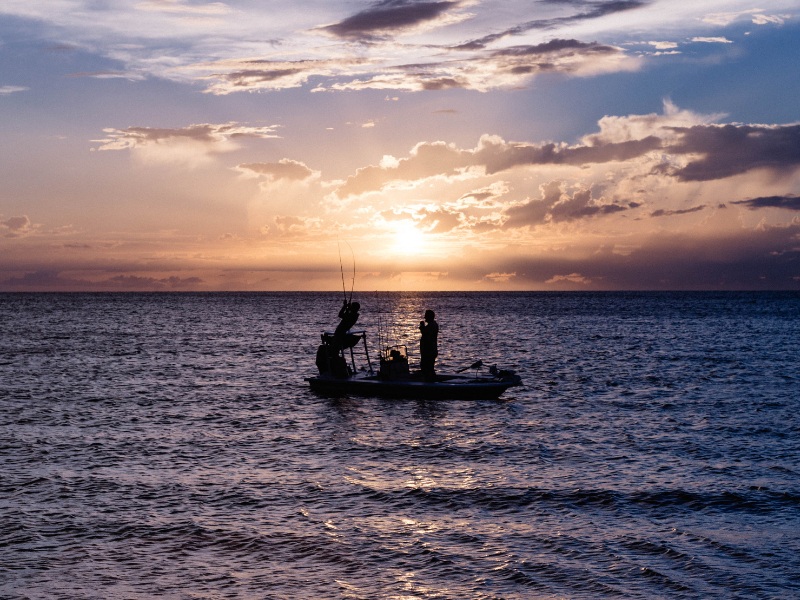
What Is The Best Wind Direction For Fishing From The Shore?
The direction of the wind has a greater impact when fishing from shore than when fishing offshore. The wind and its direction can have an immense impact on water clarity, water turbulence, the size and consistency of the waves, the temperature of the water, and how the currents flow in the water.
When fishing from shore, there are only really two wind directions that matter: wind blowing toward the coast from the sea, called onshore wind, and wind that blows from the coast toward the sea, called offshore wind.
Crosswinds are a factor as well, but they do not have as significant an effect on fishing compared to onshore and offshore wind.
The actual direction of the wind, be it North, South, East, or West, is less of a factor in this instance, as the onshore and offshore wind direction based on the compass changes depending on where you are in the world.
For this reason, there is no definitive wind direction that is best for saltwater fishing from the shore. However, every surf caster has their own preferred wind direction, be it offshore or onshore wind.
Onshore wind has the advantage of creating more turbulence in the water, which can encourage game fish to bite, provide more cover for fish which makes them more active, and has less of an effect on current than offshore wind.
Onshore wind also brings game fish closer to shore. The wind causes the waves and current to pick up more microorganisms and aquatic plant life and push it closer to shore, which brings with it fish that eat these items, which draws predatory fish closer to shore to eat the baitfish.
The onshore wind brings tiny food closer to shore. Tiny food brings prey fish closer to shore, and prey fish bring game fish closer to shore. This makes catching game fish far easier in some places when fishing from the surf.
Some anglers prefer fishing from the shore during offshore wind. In some areas, offshore wind increases the strength and intensity of waves while making them more frequent and consistent, but the water between the waves is made steadier and calmer, which increases visibility.
These larger waves also bring fish closer to shore for the same reasons that onshore winds do, which also makes fishing far better.
However, the water clarity and currents that are brought by offshore winds can make it more challenging to catch fish, as they are more likely to ignore lures or bait that they are not interested in and move away from rigs that frighten them.
There is also less cover for fish in these conditions, which makes fish wearier of potential dangers, decreasing their likelihood of biting.
This means that offshore and onshore wind both have advantages and disadvantages, and the effect these wind directions have on fishing is different in different places in the world.
Every angler must make their own decision on which wind direction is best for saltwater fishing from shore based on the success they have while fishing. Take the time to fish during offshore and onshore winds, and determine which is best in your area based on the results of the day.
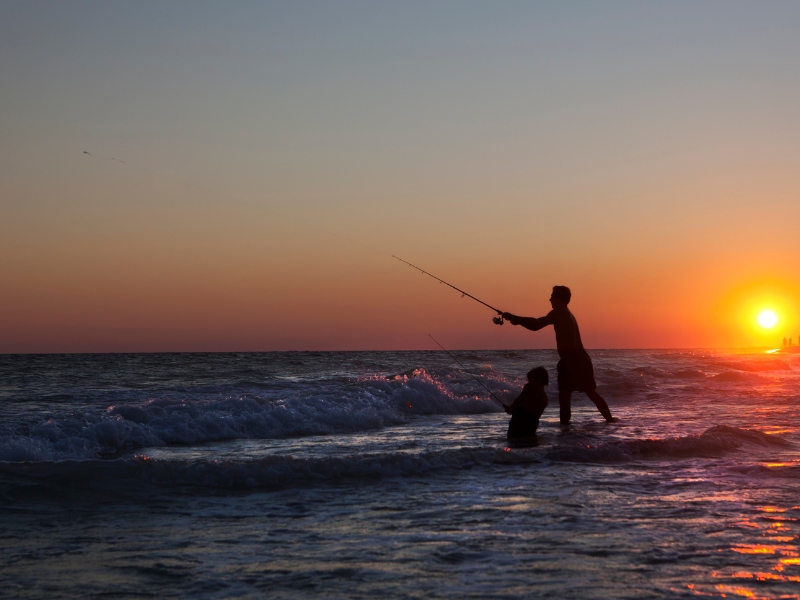
What Is The Best Wind Direction For Fishing Offshore?
Offshore fishing is not impacted by wind direction directly. Fish in open water are usually unable to perceive wind direction due to the depth and size of the water. The direction of the wind is usually caused by underlying weather conditions that do have an effect on the water and, subsequently, the fishing.
Every location on Earth has unique weather conditions and patterns. This means there is no definitive best wind direction for saltwater fishing, and the best wind direction depends on the local area where you are fishing.
The direction of the wind is usually caused by weather conditions such as temperature changes, air pressure changes, and changes in season. The direction of the wind has an impact on water currents and water temperature, and visibility, which does affect the way fish behave and how likely they are to bite.
The only way to determine the best wind direction in the area you like to fish is to look at local weather patterns and current predictions and to speak to local anglers who know the waters and how the wind affects the fishing.
Some areas are completely unaffected by the direction of the wind, and others are drastically affected and should not be fished at all when the wind is blowing a certain way.
All of these factors are specific to local areas, and every angler must take the time to explore the weather and the effect it has on the fishing for themselves.
A good indication of how the wind direction affects the fishing in your area is whether it flows against underwater currents, across the currents, or with the currents.
When the wind blows with the current, it increases the speed of the current in the area. When it blows against the current, the water is slowed down, and when it flows across the current, the water is more turbulent.
Most anglers agree that more turbulent water increases the likelihood of catching fish. When the current is flowing strongly, it can be more difficult to catch fish with specific techniques.
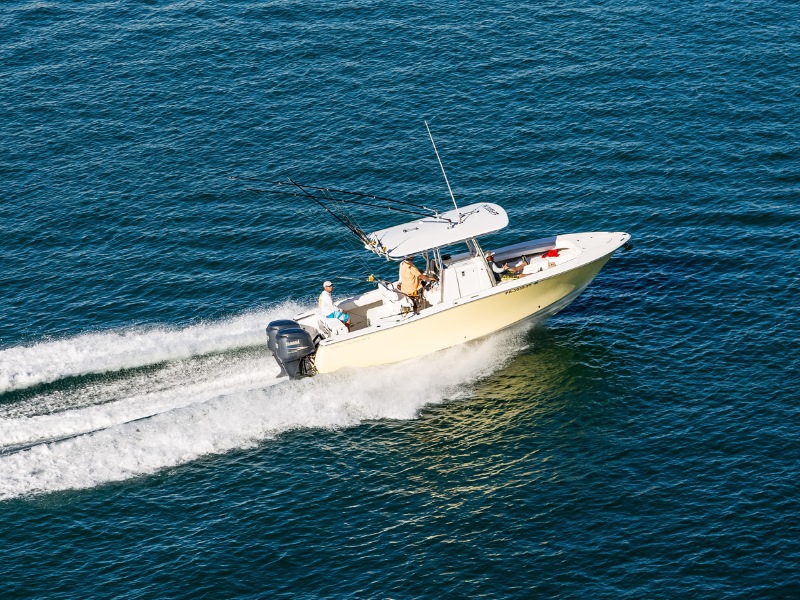
Why Does Wind Direction Affect Saltwater Fishing?
Fishing in specific areas is heavily affected by weather conditions, including wind and the direction it blows, but what about the direction of the wind affects saltwater fishing? Who does wind direction affect saltwater fishing?
The reality is that every area of the ocean has its own ecosystem. This ecosystem is in constant flux based on weather and water conditions, and even the slightest change in the balance of the ecosystem causes the fish within it to behave differently.
The direction of the wind affects saltwater fishing because the strength of the wind and the conditions that cause the wind to blow in specific directions affect the ecosystem in the water.
When the wind blows in a specific direction, it is a result of weather changes such as temperature, air pressure, rain, storms, atmospheric conditions, and several other factors. These contribute to the direction of the wind, but the same factors also affect the ecosystem in the water.
This means that the direction the wind is blowing is not the direct influence on how fish behave, but it is a marker that anglers can look for as an indication of these condition changes, as it can help them understand and predict the behavior of fish.
The wind can have a minor effect on the ecosystem, as the wind can affect water currents, the surface temperature of the water, the intensity of waves and swells, and the turbulence of the water.
When the wind makes seawater more turbulent, game fish are more likely to bite, as they feel less exposed, and the visibility in the water is decreased, which makes them more likely to bite a lure or bait without realizing that it is attached to a fishing rig.
The overall weather conditions that dictate the direction the wind blows have a significant effect on the success of saltwater fishing. As the fish respond to changes in temperature, turbulence, water clarity, and air pressure, game fish move with prey fish when the food items they eat are moved by water currents and winds.
For these reasons, it is vital that anglers learn the local weather patterns in their favorite fishing areas and base their fishing trips on these factors, as there is no international standard for fishing according to the direction of the wind.
How To Tell When The Wind Is Good For Saltwater Fishing
We have established that the is no standard ideal wind direction for saltwater fishing and that every area is affected differently by wind, but there are ways and methods to use that can help determine when the wind direction is beneficial for fishing and when it is detrimental to fishing in saltwater.
It is critical that anglers learn to look for these signs to use the wind to their advantage and to learn to make the most of the weather conditions that they find themselves fishing in.
To determine if the wind direction is good for saltwater fishing, simply analyze the water you are fishing in, and look at how the fish behave.
If the wind is causing the water to flow toward you, bringing with it baitfish that will, in turn, bring gamefish, the wind is in a good direction for fishing. This is true for offshore fishing and fishing from shore.
If the wind is causing the water to be too erratic for consistent fishing, or if the wind is causing food items to flow away from you, then the wind is not blowing in a good direction for fishing.
This is less of an issue when you are in a boat, as you can change position and move to a better location based on the wind. But if you are fishing from the shore, you may need to find a different fishing location or wait until the wind changes before you have any success.
If the direction of the wind makes it impossible for you to cast your rig where you want it to be, then it is better to wait until the wind changes before continuing.
However, if the wind is conducive to casting well and casting in the direction you want to fish, then the wind direction is a great advantage while fishing.
The direction of the wind also affects currents and water temperature. If the wind causes sea currents to intensify, you may find it very difficult to catch fish, as all the food items the fish are looking for will be carried away with the current.
Instead of fighting the wind, find a fishing location further down the current where you are more likely to catch fish.
If the wind makes the water temperature too cold, fish are less likely to bite, as they are more active when the water is water.
However, if the wind and its direction cause warm water to cool down slightly, it may set the water to the correct temperature for fish to food. In this instance, fish with the wind as much as possible, and the fish will be drawn to the areas where the water is cooled by the wind.
All of these factors must be considered by anglers when saltwater fishing. If you look for these factors based on the direction of the wind and the effect it has on the water and the fish, you are sure to find ways to work around poor wind conditions or find ways that the wind can benefit your fishing.

How To Adjust Saltwater Fishing Based On Wind Direction
The direction of the wind can have a significant impact on the success of fishing, but it can be difficult to adjust to the wind and find ways to fish successfully despite the direction it is blowing.
What can an anglers do to make the most of the wind direction while saltwater fishing?
If you are fishing offshore in a boat that can overcome the water currents, the best way to work with the wind rather than being hindered by it is to position yourself in a location and orientation that allows you to take advantage of the wind.
Position yourself in an orientation that allows you to cast with the wind and move downstream from the current that is pushing fish and food items along in the water. If you place your boat in the water along the current and fish with the current, your bait may be carried right into the mouth of a target fish.
However, you can also position your boat against the current and fish into the current against the wind, as this means that fish will be washed into your rig by the current, increasing the chances of a bite.
If you are fishing from shore, the best way to take advantage of the wind is to look for fish. If you can find where the fish are, then position yourself to reach that area with your rig.
This may involve fishing with the wind or fishing against it, depending on the position of the fish in the water.
Take the time to do this investigation before you begin fishing, and your day is far more likely to be successful.
Conclusion
There is no universal best wind direction for saltwater fishing, but every area has its own best wind direction. It is important for every angler to determine this direction for themselves based on where they are in the world.
Take the time to determine the best wind direction in your area that helps you catch more fish, and your experience on the water is sure to be positive, and you will surely catch more fish. This takes effort and time, but it is worthwhile.
- Do You Need An Indicator For Nymph Fishing? - November 16, 2023
- Fishing Safety Tips For Families - September 25, 2023
- What Is The Best Time To Night Fish At A Lake? - September 18, 2023


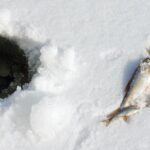
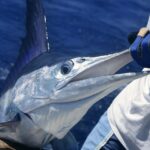
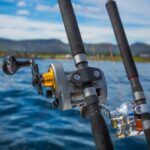
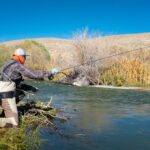
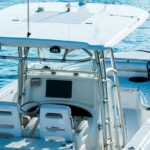

![Kayak Fishing for Beginners [10 Tips for a Successful Trip] fishing kayak moored on a beach](https://irvinelake.net/wp-content/uploads/2022/12/kayak-fishing-for-beginners-150x150.png)